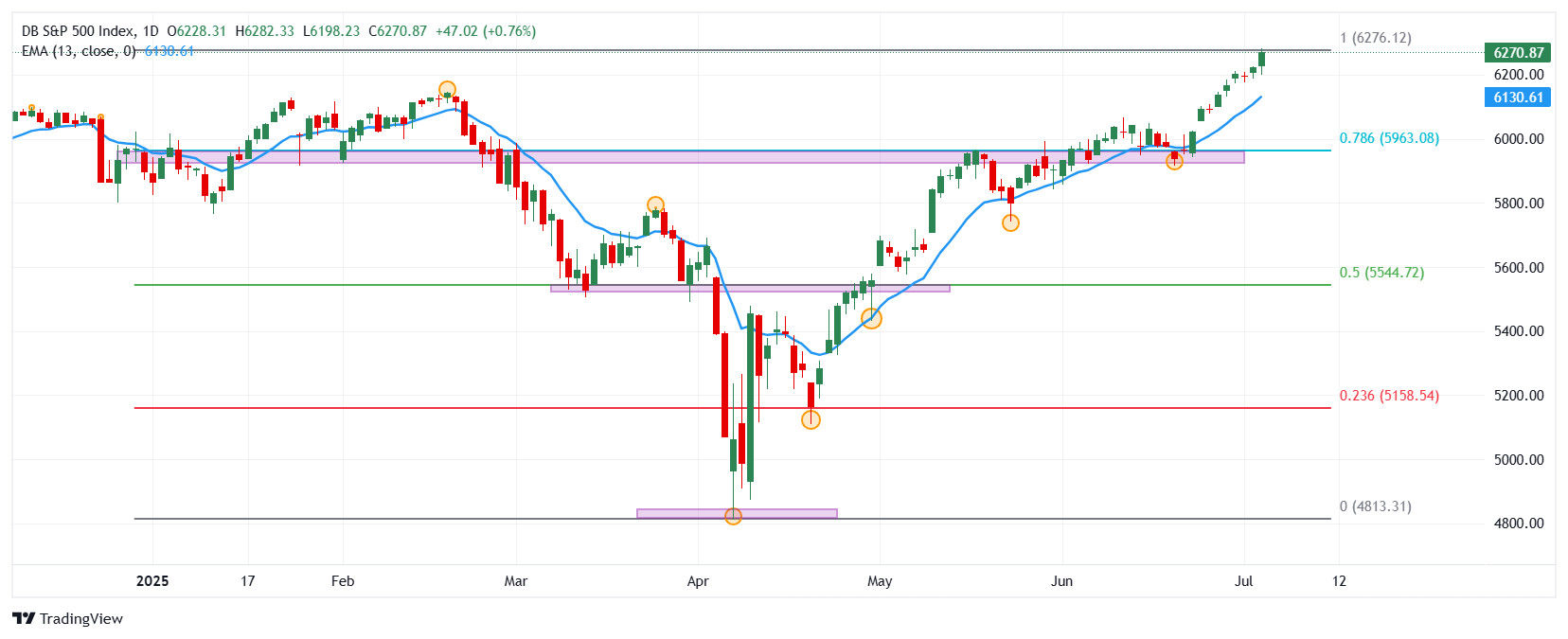- The S&P 500 stock index wins 0.76% daily, signing new historical maximums in 6,282.
- Cadence Design Systems (CDNS) shares rise 5.10% today, registering new historical maximums at $ 330.09.
- The First Solar (FSLR) values advance 8.51% on Thursday, contributing currently in 185.03 $.
- Non -agricultural payrolls increase to 147,000, improving analysts projections.
- The ISM services PMI increased to 50.8 points, above the 50.5 market.
The S&P 500 established a minimum of the day in 6,198, where it found aggressive buyers who took the index to new historical maximums in 6,282. Currently, the S&P 500 is traded at 6,270, rising 0.76% in the day.
The S&P 500 records new historical maximums per second consecutive day
Based on information presented by the Institute of Offer Administration (ISM), the PMI of Services rises to 50.8 points, exceeding the estimates of the 50.5 points and 49.9 observed the previous month.
At the same time, non -agricultural payrolls increased to 147,000 in June, located above the estimated 110,000 and the 144,000 registered in May.
On the other hand, the First Solar Titles (FSLR) shoot 8.51% today, reaching May 15 in 189.50 $, spinning two consecutive days with profits.
In the same tonic, the values of Cadence Design Systems (CDNS) present an advance of 5.10% on Thursday, reaching historical maximums in 330.09 $, signing eight consecutive sessions upward.
The S&P 500 wins 47 points daily, registering new historical maximums in 6,282, extending yesterday’s profits.
Levels to be considered in the S&P 500
The S&P 500 established a short -term support given by the minimum of May 23 in 5,742. The following key support is found in 5.430, given by the minimum of April 30 in convergence with the exponential mobile average of 13 periods. To the north, we project a possible profits in 6,600, a closed number that converges with the extension to 127.2% of Fibonacci.
S&P 500 DAILY GRAPH

S&P 500 – Frequently Questions
The S&P 500 is a very often stock index that measures the yield of 500 public companies and is considered a wide measure of the US stock market. The influence of each company on the calculation of the index is weighted based on stock capitalization. This is calculated by multiplying the number of bought shares of the company for the price of the action. The S&P 500 index has achieved impressive yields: 1.00 $ invested in 1970 would have produced a yield of almost $ 192.00 in 2022. The average annual profitability since its creation in 1957 has been 11.9%.
Companies are selected by Committee, unlike other indices that are included based on established standards. Even so, they must fulfill certain eligibility criteria, the most important of which is stock market, which must be equal to or greater than 12.7 billion dollars. Other criteria are liquidity, domicile, stock capitalization, sector, financial viability, quotation time and representation of the sectors of the United States economy. The nine largest companies in the index represent 27.8% of the stock market capitalization.
There are several ways to operate with the S&P 500. Most of the Stred Betting retail runners and platforms allow operators to use contracts per difference (CFD) to make bets on the price direction. In addition, indexed funds, investment funds and quoted funds (ETF) that follow the price of the S&P 500 can be purchased. The most ETF liquid is the ETF of the London Stock Exchange. The most ETF liquid is the State Street Corporation Spy. The Chicago Mercantile Exchange (CME) offers futures contracts on the index and the Chicago Board of Options (CMOE) offers options, as well as ETF, ETF Inverse and ETF leverage.
There are many factors that promote S&P 500, but mainly it is the aggregate performance of the companies that compose it, revealed in their reports of quarterly and annual results. American and world macroeconomic data also contribute, since they influence investors’ confidence, which is positive drives profits. The level of interest rates, set by the Federal Reserve (FED), also influences the S&P 500, since it affects the cost of credit, which is largely depending on many companies. Therefore, inflation can be a determining factor, as well as other parameters that influence the decisions of the Federal Reserve.
Source: Fx Street
I am Joshua Winder, a senior-level journalist and editor at World Stock Market. I specialize in covering news related to the stock market and economic trends. With more than 8 years of experience in this field, I have become an expert in financial reporting.







